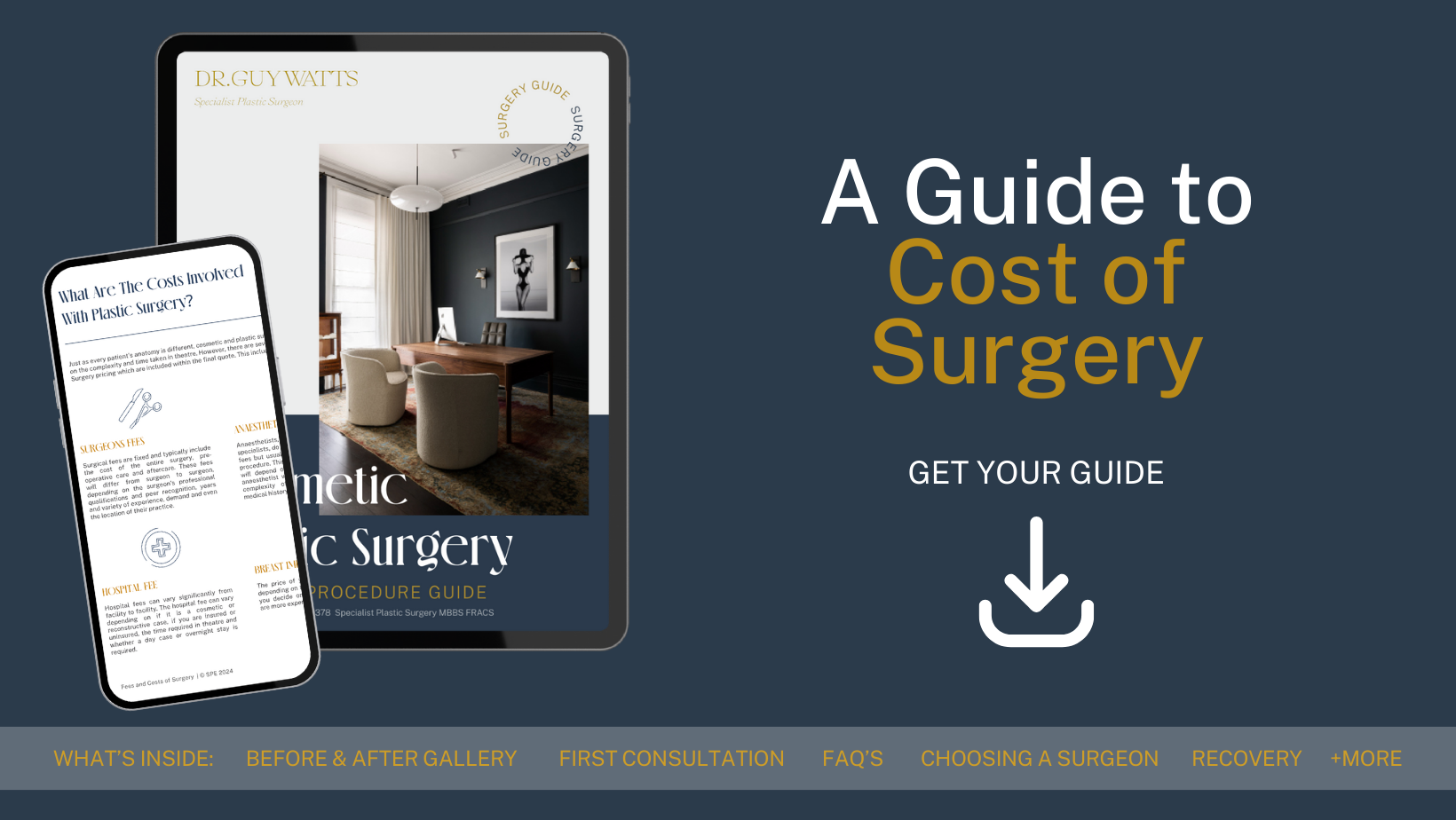Gliding Brow Lift in Perth with Specialist Plastic Surgeon Dr. Guy Watts
 A gliding brow lift is a cosmetic surgical procedure designed to address the upper face, particularly the outer portion of the eyebrows and the forehead. This technique focuses on lifting and repositioning the outer third of the eyebrows. Unlike a traditional full brow lift, the gliding brow lift is less invasive and targets specific areas, resulting in a subtle outcome. The procedure is used to address lines in the forehead and reduce heaviness in the upper eyelid area. It may also contribute to a more open appearance of the eyes.
A gliding brow lift is a cosmetic surgical procedure designed to address the upper face, particularly the outer portion of the eyebrows and the forehead. This technique focuses on lifting and repositioning the outer third of the eyebrows. Unlike a traditional full brow lift, the gliding brow lift is less invasive and targets specific areas, resulting in a subtle outcome. The procedure is used to address lines in the forehead and reduce heaviness in the upper eyelid area. It may also contribute to a more open appearance of the eyes.
Perth Specialist Plastic Surgeon Dr. Guy Watts offers gliding brow lift surgery, as well as other face procedures such as facelift and neck lift.
What Is a Gliding Brow Lift?
A gliding brow lift is a modern surgical technique designed to elevate the eyebrows and address forehead wrinkles. Unlike traditional brow lift methods, the gliding brow lift focuses on a less invasive procedure while providing results that last over time. The procedure involves repositioning the brow tissue through small incisions, allowing for a less furrowed forehead and a more elevated brow position without extensive scarring or downtime.
REQUEST AN APPOINTMENT
Who Is a Good Candidate for Gliding Brow Lift?
You might be a good candidate for a gliding brow lift if you:
- Have drooping or heavy eyebrows
- Have deep horizontal furrows in your forehead
- Are in good general health without unmanaged medical conditions
- Have realistic expectations about the outcomes of the surgery
- Do not smoke, or are willing to quit smoking before and after surgery
A consultation with Dr. Guy Watts will help determine if a gliding brow lift is suitable for you. He will assess your facial anatomy, discuss your goals, and recommend an approach which may align with your desired results.
DOWNLOAD DR WATTS’ GUIDE TO COST OF SURGERY

What Can Gliding Brow Lift Surgery Do for Me?
Undergoing a gliding brow lift may provide benefits such as:
- Elevate Sagging Brows: Restores the natural arch and position of your eyebrows, opening up the eye area.
- Smooth Forehead Wrinkles: Reduces horizontal lines and furrows on your forehead, giving the skin a smoother look.
- Reduce Frown Lines: Minimises vertical frown lines between the eyebrows.
How Is the Surgery Performed?
Undergoing a gliding brow lift is a significant step, and becoming familiar with the surgical process can help ease any concerns you might have. The procedure is planned and executed by Dr. Guy Watts to ensure optimal results.
Anaesthesia
Your comfort and safety are paramount throughout the surgery. The gliding brow lift is typically performed under general anaesthesia or intravenous (IV) sedation:
- General Anaesthesia: This method ensures you’re completely asleep and unaware during the procedure.
- Intravenous Sedation: Also known as “twilight sedation,” this involves administering sedatives through an IV to relax you deeply while local anaesthesia numbs the surgical area.
Dr. Watts will discuss the most suitable anaesthesia option for you during your pre-operative consultation, taking into account your medical history and personal preferences.
Incision Placement
The gliding brow lift uses specific techniques to reduce visible scarring. The placement of incisions depends on the chosen surgical approach:
- Endoscopic Gliding Brow Lift: Small incisions, typically less than an inch long, are made behind the hairline across the scalp. This allows the endoscope and surgical instruments to be inserted without noticeable scars.
- Temporal Gliding Brow Lift: Incisions are discreetly placed within the hairline at the temples. This approach focuses on lifting the outer brow area and smoothing crow’s feet wrinkles.
- Direct Gliding Brow Lift: Incisions are made just above the eyebrows. Although this method may result in more visible scarring, it’s effective for significant brow drooping and allows precise correction.
These incisions provide access to the underlying forehead structures while keeping scars as hidden as possible.
Tissue Adjustment
Once the incisions are made, Dr. Watts will carefully:
- Elevate the Skin: Gently lifting the forehead skin to expose the underlying muscles and tissues.
- Reposition Muscles and Tissues: Using specialised instruments, he adjusts the muscles responsible for frown lines and sagging brows. This may involve releasing tight muscles and lifting or reshaping others to achieve a smoother forehead.
- Remove Excess Tissue: Any surplus skin or fatty tissue contributing to drooping or wrinkles is removed. This step is important for creating a natural-looking lift and eliminating deep furrows.
Throughout this process, Dr. Watts employs different techniques to preserve nerve function and reduce tissue trauma, promoting a smoother recovery.
Securing the Brows
With the brow tissues adjusted, the next step is to secure them in their new, elevated position:
- Internal Sutures: Dissolvable stitches may be placed within the tissues to hold the brows in place.
- Endoscopic Fixation Devices: Small, absorbable implants or anchors may be used to secure the elevated tissues during healing.
- Temporal Securing: In temporal lifts, the tissues are repositioned and secured at the temples using sutures anchored to the deep temporal fascia.
These methods ensure that the brows remain in the desired position as you heal, contributing to long-lasting results.
Closing Incisions
After securing the brows, Dr. Watts will close the incisions with:
- Sutures: Fine stitches meticulously placed to reduce scarring.
- Staples: In some cases, especially within the hair-bearing scalp, staples may be used for efficiency and to reduce hair follicle damage.
- Surgical Tape or Glue: Applied over the incisions to support healing and protect the area.
Great care is taken to align the tissues properly, promoting optimal healing and the least noticeable scars.
Bandaging
Once the incisions are closed, your forehead may be:
- Wrapped in a Soft Bandage: To provide compression, reduce swelling, and protect the surgical sites.
- Fitted with a Compression Garment: In some cases, a specialised headband or garment is used to support the new brow position.
These dressings are usually lightweight and designed for comfort, allowing you to rest and recover without significant discomfort.
Duration of the Surgery
The gliding brow lift procedure typically takes one to two hours. The exact time depends on factors such as:
- Extent of Correction Needed: More significant sagging or asymmetry may require additional surgical time.
- Chosen Technique: Endoscopic methods may take longer due to the use of specialised equipment.
- Combination with Other Procedures: If you’re having additional surgeries (e.g., eyelid surgery), the overall time will increase.
After the Surgery
Immediately following the procedure:
- Recovery Room: You’ll be taken to a recovery area where trained staff will monitor you as you wake from anaesthesia.
- Discharge: Depending on the anaesthesia used and your individual response, you may go home the same day. Arrange for someone to drive you, as you’ll be unable to operate a vehicle.
- Post-Operative Instructions: Dr. Watts will provide detailed guidelines on caring for your incisions, managing discomfort, and recognising signs of potential complications.
Recovery after Surgery
Post-operative recovery is important for optimal results. Here’s an overview of what to expect:
- Immediate Aftercare: You’ll spend some time in a recovery area where monitoring continues as you wake from anaesthesia.
- Swelling and Bruising: It’s normal to experience swelling and bruising around the forehead and eyes, which should subside within two weeks.
- Pain Management: Any discomfort can usually be managed with prescribed pain medication.
- Bandages and Dressings: You may need to keep bandages on for a few days. Sutures or staples are typically removed within a week.
- Activity Restrictions: Avoid strenuous activities, heavy lifting, and bending over for at least two weeks to reduce swelling and bleeding risk.
- Sleeping Position: Elevate your head while sleeping to help reduce swelling.
- Follow-up Appointments: Attend all scheduled appointments with Dr. Watts to monitor your healing progress.
Most patients return to work and normal activities within 10 to 14 days, but complete healing may take several weeks.
Risks of Gliding Brow Lift
A gliding brow lift, like all surgical procedures carry some risks:
- Infection: Rare, but can occur. Antibiotics may be prescribed to prevent or treat infections.
- Bleeding or Haematoma: Accumulation of blood under the skin may require drainage.
- Scarring: Incisions are made in discreet locations, but scars are permanent. They might fade over time.
- Nerve Injury: Temporary or permanent changes in sensation or movement of the forehead or scalp.
- Hair Loss: Hair follicles near the incision sites may be affected, resulting in temporary or permanent hair loss.
- Asymmetry: Slight differences in brow height or shape can occur.
- Anaesthesia Risks: Adverse reactions to anaesthesia are rare but possible.
Dr. Watts will discuss all potential risks and complications with you during the consultation to ensure you make an informed decision.









